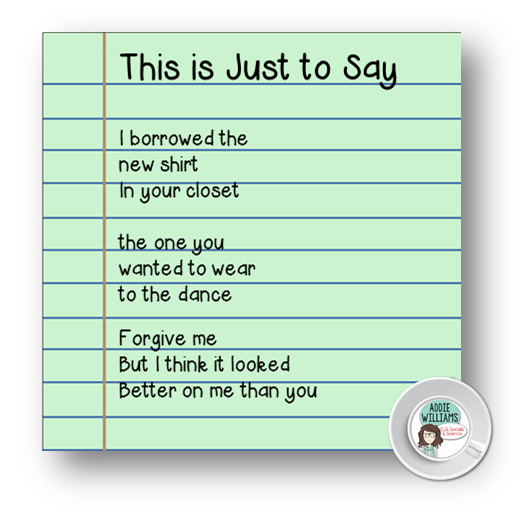Welcome to the classroom component of the Academy of American Poets 2019 National Poetry Month education project, Dear Poet.The following unit incorporates multimedia and classroom activities to encourage students to explore and interact with poetry by first writing letters to important historical poets as practice for writing letters to the Academy of American Poets Board of. Blackout poetry is a good starting point for new poets because the words are already on the page and students only need to determine which words to use. This strategy can also be used as an interdisciplinary assignment in which students use text from specific content to create a poem about that content, such as using the Bill of Rights to. With a little bit of ingenuity, poetry units can be the highlight of your school year, even if it’s not your favorite part of teaching ELA. Hopefully these simple takeaways have inspired you to try something new with your next poetry unit. If you have successful poetry activities or lessons to share, we’d love to hear about them.
- Senior Years Poetry Uniteffective Curriculum Ideas Free
- Senior Years Poetry Uniteffective Curriculum Ideas 2020
- Senior Years Poetry Uniteffective Curriculum Ideas Printable
- Senior Years Poetry Uniteffective Curriculum Ideas List
This post contains affiliate links.
April is National Poetry Month!
I’ve gathered up lots of free poetry printables and resources for you to use with your kids. I tried to be selective, choosing websites loaded with lessons and printables. Don’t make a chore out of reading and writing poetry – just have fun with it!!
Interactive Poetry Center Links:

<A HREF=”http://ws-na.amazon-adsystem.com/widgets/q?rt=tf_cw&ServiceVersion=20070822&MarketPlace=US&ID=V20070822%2FUS%2Farwethye-20%2F8010%2F394b9ccb-3861-4e18-93e1-4bba551c3ec7&Operation=NoScript”>Amazon.com Widgets</A>
Seasonal Poetry & Art Units:
Acrostic Poem Printables

<A HREF=”http://ws-na.amazon-adsystem.com/widgets/q?rt=tf_cw&ServiceVersion=20070822&MarketPlace=US&ID=V20070822%2FUS%2Farwethye-20%2F8010%2Fd3691a71-4968-4050-86ee-1fbe4beb97cb&Operation=NoScript”>Amazon.com Widgets</A>

Poet Websites:
Senior Years Poetry Uniteffective Curriculum Ideas Free
Christina Rossetti Poems to Color
Teaching with Nursery Rhymes
Do you have a favorite children’s poet?

Poetry Out Loud is not intended to replace classroom activities like creative writing. In fact, the two naturally complement each other. For that reason, we have created a number of optional writing activities and lesson plans for teachers.
Do you have some great Poetry Out Loud lesson plans? Email us at mail@poetryoutloud.org to share your ideas!
For further ideas on poetry instruction, visit the Poetry Foundation’s Learning section.
Poems Put to Use (PDF)
Students write about poems being put to use and, in the process, imagine the practical advantages of poem memorization and recitation.
Senior Years Poetry Uniteffective Curriculum Ideas 2020
The Tabloid Ballad (PDF)
This lesson teaches students about the typical metrical forms and narrative structure of the ballad by having them write ballads based on comic, even outrageous source material.
The Tone Map (PDF)
As students learn to name the tones of voice that the poem moves through, they learn to describe mixed emotions and to distinguish subtle shifts in tone and mood.
Senior Years Poetry Uniteffective Curriculum Ideas Printable
Poetry, Celebrity, and the Power of Connotation (PDF)
Students learn to recognize some of the most common strategies that poets use when writing about historical figures. With these in mind, students then hunt up and present other poems about historical figures.
Senior Years Poetry Uniteffective Curriculum Ideas List
Golden Shovel(PDF)
Students learn to read and write poems through a new form.
In Another’s Voice (PDF)
This lesson focuses on poems that enter into a voice other than the poet’s, perhaps not even a human voice, so that students can explore the dramatic possibilities within a poem.
Keeping Score (PDF)
In this lesson, students practice close readings of poems by analyzing the style—what musicians call the “dynamics” —of the poem: its volume, speed, language, syntax, lineation, and punctuation.
Poetry As Ceremony(PDF)
This lesson focuses on poems that have the sound of ritual, often with an incantatory rhythm that can guide students in memorization and performance.
Visualizing Voice (PDF)
In this lesson, students will practice close reading by deciding points of emphasis within a poem.
Line Dancing (PDF)
This exercise will help students become more comfortable with line breaks, to think about the ways in which they can inform not only the meaning of a poem on the page, but also how understanding line breaks may aid in the performance of poetry out loud as well.
Lesson Plans by Eileen Murphy that complement Poetry Out Loud
Papa's burgeria to go. Sonic Patterns: Exploring Poetic Techniques Through Close Reading
Students use the idea of a composed memory and their knowledge of sonic patterns to draft, revise, and share their own original text.
Speaking Poetry: Exploring Sonic Patterns Through Performance
Students engage in a variety of vocal activities and performance techniques based on word sounds and then prepare a recitation for small group performances and compare their interpretative choices as part of the reflection process.

